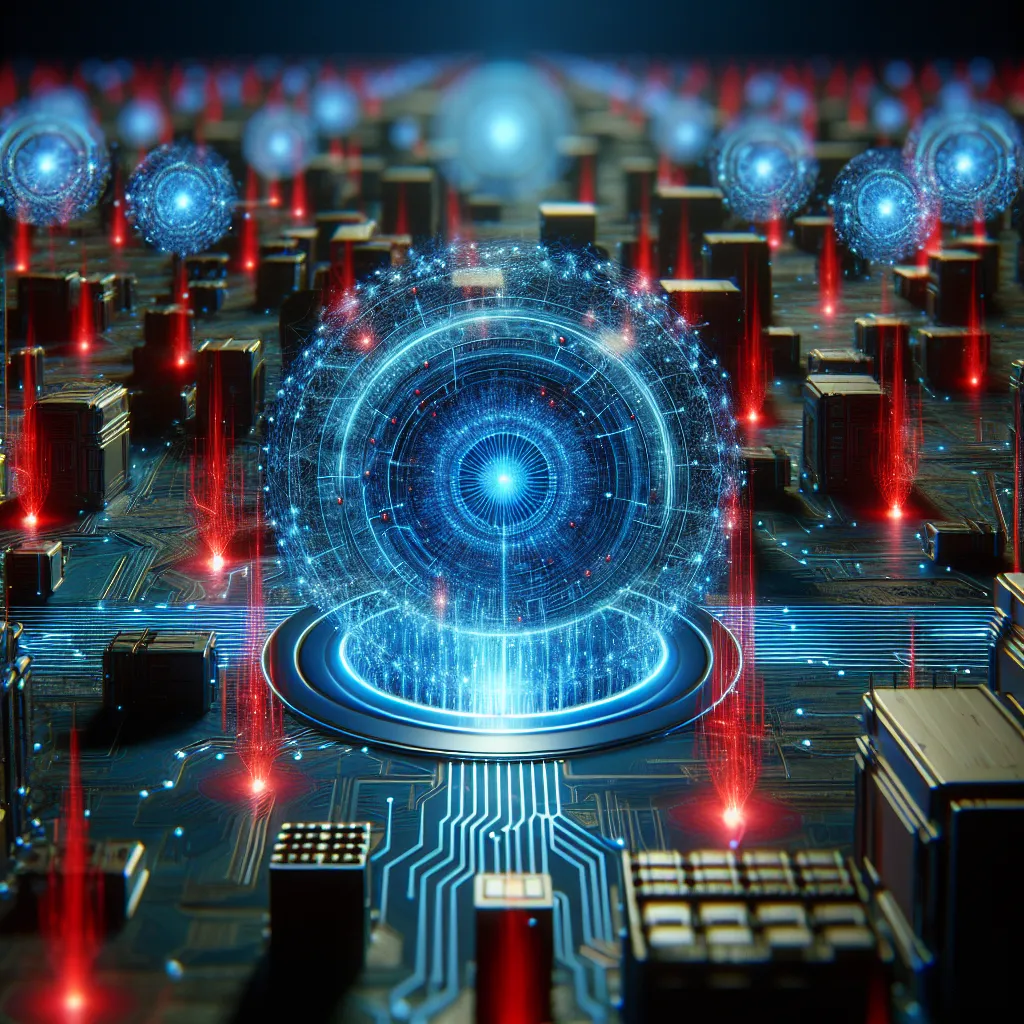As an experienced IELTS instructor, I’m excited to share a comprehensive practice test focusing on “The Role of AI in Combating Cybersecurity Threats.” This topic is not only relevant to modern technology but also frequently appears in IELTS Reading tests. Let’s dive into a full-length IELTS Reading practice test, complete with passages, questions, and answers.
Nội dung bài viết
 AI Cybersecurity Protection
AI Cybersecurity Protection
IELTS Reading Practice Test
Passage 1 (Easy Text)
Artificial Intelligence: The New Frontier in Cybersecurity
In recent years, the landscape of cybersecurity has undergone a significant transformation. As cyber threats become increasingly sophisticated, traditional defense mechanisms are struggling to keep pace. Enter Artificial Intelligence (AI), a game-changing technology that is revolutionizing the way we approach cybersecurity.
AI’s role in cybersecurity is multifaceted. Firstly, it enhances threat detection capabilities. Machine learning algorithms can analyze vast amounts of data in real-time, identifying patterns and anomalies that might indicate a cyber attack. This proactive approach allows organizations to detect and respond to threats much faster than human analysts could.
Moreover, AI systems can adapt and learn from new threats, continuously improving their defense strategies. This adaptive learning is crucial in an environment where cyber criminals are constantly developing new attack methods. AI can quickly recognize new malware variants or zero-day exploits, providing a level of protection that was previously unattainable.
Another significant advantage of AI in cybersecurity is its ability to automate routine tasks. This automation frees up human experts to focus on more complex security issues, improving overall efficiency. For instance, AI can handle tasks like patch management and system updates, ensuring that vulnerabilities are addressed promptly.
However, the integration of AI in cybersecurity is not without challenges. There are concerns about the potential for AI systems to be manipulated or fooled by adversarial attacks. Additionally, the ethical implications of AI decision-making in security contexts need careful consideration.
Despite these challenges, the potential of AI in strengthening cybersecurity defenses is undeniable. As cyber threats continue to evolve, the role of AI in protecting our digital assets is likely to become even more critical.
Questions 1-7
Do the following statements agree with the information given in the passage? Write
TRUE if the statement agrees with the information
FALSE if the statement contradicts the information
NOT GIVEN if there is no information on this
- Traditional cybersecurity methods are keeping up with modern threats.
- AI can analyze data faster than human analysts.
- Machine learning algorithms can identify patterns indicating cyber attacks.
- AI systems cannot learn from new threats.
- Automation of routine tasks by AI allows human experts to focus on complex issues.
- There are no challenges associated with using AI in cybersecurity.
- The ethical implications of AI in cybersecurity are fully understood.
Questions 8-10
Complete the sentences below. Choose NO MORE THAN TWO WORDS from the passage for each answer.
- AI can quickly recognize new malware variants or , providing enhanced protection.
- AI can handle tasks like patch management and , addressing vulnerabilities promptly.
- There are concerns about AI systems being fooled by .
Passage 2 (Medium Text)
The Synergy of AI and Human Expertise in Cybersecurity
The integration of Artificial Intelligence (AI) into cybersecurity practices has marked a paradigm shift in how organizations defend against digital threats. However, it’s crucial to understand that AI is not a standalone solution but rather a powerful tool that enhances human expertise. This synergy between AI capabilities and human insight is what truly elevates cybersecurity to new heights.
AI excels in processing and analyzing vast amounts of data at speeds incomprehensible to humans. In the realm of cybersecurity, this translates to real-time threat detection and response. Machine learning algorithms can sift through network traffic, identifying anomalies that might indicate a breach or an impending attack. These systems can learn from historical data, continuously improving their ability to recognize new and evolving threats.
One of the most significant advantages of AI in cybersecurity is its ability to automate routine tasks. This automation not only increases efficiency but also reduces the risk of human error. For instance, AI can handle patch management, ensuring that all systems are up-to-date with the latest security fixes. It can also automate the process of log analysis, flagging suspicious activities that warrant further investigation.
However, the role of human experts remains indispensable. While AI can process data and identify patterns, it lacks the nuanced understanding and creative problem-solving abilities of humans. Cybersecurity professionals bring context, experience, and intuition to the table. They can interpret AI-generated insights, make strategic decisions, and develop innovative solutions to complex security challenges.
Moreover, human oversight is crucial in managing the ethical implications of AI in cybersecurity. Questions about privacy, data protection, and the potential for AI systems to be manipulated need careful consideration. Cybersecurity professionals play a vital role in ensuring that AI tools are used responsibly and in alignment with organizational values and regulatory requirements.
The future of cybersecurity lies in the seamless integration of AI capabilities with human expertise. This collaboration allows organizations to leverage the strengths of both: the speed and data-processing power of AI, and the creativity and contextual understanding of humans. As cyber threats continue to evolve in complexity and scale, this synergistic approach will be essential in maintaining robust digital defenses.
However, challenges remain in fully realizing this synergy. There’s a need for ongoing training and education to ensure that cybersecurity professionals can effectively work alongside AI systems. Organizations must also invest in developing AI tools that are transparent and explainable, allowing human experts to understand and trust the AI-generated insights.
In conclusion, while AI is revolutionizing cybersecurity, it’s the combination of AI and human expertise that truly fortifies our digital defenses. As we move forward, nurturing this synergy will be key to staying ahead in the ever-evolving landscape of cyber threats.
Questions 11-15
Choose the correct letter, A, B, C, or D.
-
According to the passage, AI in cybersecurity is:
A) A standalone solution
B) A replacement for human experts
C) A tool that enhances human expertise
D) Ineffective against modern threats -
The main advantage of AI in processing data for cybersecurity is:
A) Its ability to make ethical decisions
B) Its speed and capacity to handle large volumes
C) Its creative problem-solving abilities
D) Its nuanced understanding of threats -
Automation of routine tasks by AI in cybersecurity:
A) Increases the risk of human error
B) Reduces efficiency
C) Eliminates the need for human involvement
D) Increases efficiency and reduces human error risk -
The role of human experts in cybersecurity is described as:
A) Obsolete due to AI
B) Limited to routine tasks
C) Indispensable for interpretation and strategy
D) Unnecessary in threat detection -
The passage suggests that the future of cybersecurity lies in:
A) Completely replacing humans with AI
B) Using only traditional security methods
C) Integrating AI capabilities with human expertise
D) Relying solely on human experts
Questions 16-20
Complete the summary below. Choose NO MORE THAN TWO WORDS from the passage for each answer.
AI in cybersecurity excels at processing large amounts of data and performing (16) . It can handle tasks like (17) and log analysis. However, human experts are still essential as they provide (18) and creative problem-solving abilities. They also play a crucial role in managing the (19) of using AI in cybersecurity. The future of cybersecurity depends on the (20) of AI capabilities and human expertise.
Passage 3 (Hard Text)
The Double-Edged Sword: AI’s Dual Role in Cybersecurity
The integration of Artificial Intelligence (AI) into cybersecurity represents a significant leap forward in our ability to defend against digital threats. However, this technological advancement is not without its complexities and potential drawbacks. As AI becomes increasingly sophisticated in protecting digital assets, it simultaneously poses new challenges and risks in the cybersecurity landscape.
At its core, AI’s strength in cybersecurity lies in its unparalleled ability to process and analyze vast amounts of data at speeds far beyond human capability. Machine learning algorithms can swiftly identify patterns and anomalies in network traffic, potentially indicating a cyber attack. This rapid detection and response mechanism significantly enhances an organization’s security posture. Moreover, AI systems can adapt and evolve their defense strategies in real-time, learning from new threats and continuously improving their protective measures.
The automation capabilities of AI in cybersecurity are particularly noteworthy. Routine tasks such as patch management, system updates, and preliminary threat assessments can be efficiently handled by AI systems. This automation not only reduces the workload on human security professionals but also minimizes the risk of human error in these critical but repetitive tasks. Consequently, cybersecurity experts can focus their efforts on more complex, strategic aspects of security management.
However, the very strengths that make AI a powerful ally in cybersecurity also present potential vulnerabilities. As AI systems become more integral to defense mechanisms, they themselves become targets for cyber criminals. Adversarial attacks, designed to manipulate or fool AI systems, are an emerging threat. These attacks exploit the way AI algorithms process data, potentially causing them to make erroneous decisions or classifications. For instance, slight modifications to malware code that are imperceptible to human analysts might cause an AI system to misclassify a threat as benign.
Furthermore, the reliance on AI in cybersecurity raises significant ethical and privacy concerns. AI systems require vast amounts of data to function effectively, which can include sensitive information about network behaviors and user activities. The collection and analysis of this data must be balanced against privacy rights and data protection regulations. There’s also the question of accountability: in a system where AI makes critical security decisions, determining responsibility for breaches or false positives becomes more complex.
Another consideration is the potential for AI to be used offensively by cyber criminals. Just as defensive AI systems evolve to detect threats, offensive AI can be employed to create more sophisticated attack vectors. This could lead to an AI arms race in the cyber realm, where defensive and offensive technologies continually try to outmaneuver each other.
The black box problem in AI also poses challenges in the context of cybersecurity. Many AI systems, particularly deep learning models, operate in ways that are not easily interpretable by humans. This lack of transparency can be problematic in security contexts, where understanding the rationale behind a system’s decisions is crucial for trust and accountability.
Moreover, the implementation of AI in cybersecurity requires significant resources and expertise. Organizations must invest in both technology and talent to effectively leverage AI, potentially widening the gap between those who can afford advanced AI-driven security and those who cannot. This disparity could create new vulnerabilities in the overall digital ecosystem.
Despite these challenges, the potential of AI to revolutionize cybersecurity is undeniable. The key lies in developing AI systems that are not only powerful but also transparent, ethical, and resilient to manipulation. This requires a multidisciplinary approach, combining expertise in AI, cybersecurity, ethics, and policy.
In conclusion, while AI offers unprecedented capabilities in combating cyber threats, it also introduces new complexities and potential vulnerabilities. As we continue to integrate AI into our cybersecurity strategies, a balanced approach that leverages the strengths of AI while actively addressing its limitations and risks is essential. The future of cybersecurity will likely be shaped by our ability to navigate this delicate balance, ensuring that AI remains a powerful tool for defense rather than a double-edged sword.
Questions 21-26
Complete the sentences below. Choose NO MORE THAN TWO WORDS AND/OR A NUMBER from the passage for each answer.
-
AI’s main strength in cybersecurity is its ability to process and analyze of data quickly.
-
AI systems can adapt their in real-time, learning from new threats.
-
The automation capabilities of AI in cybersecurity help reduce the risk of in critical tasks.
-
are designed to manipulate or fool AI systems, exploiting how they process data.
-
The collection and analysis of data by AI systems must be balanced against and data protection regulations.
-
The in AI refers to the lack of transparency in how some AI systems make decisions.
Questions 27-32
Do the following statements agree with the claims of the writer in the passage? Write
YES if the statement agrees with the claims of the writer
NO if the statement contradicts the claims of the writer
NOT GIVEN if it is impossible to say what the writer thinks about this
- AI in cybersecurity is completely secure and cannot be targeted by cyber criminals.
- The use of AI in cybersecurity raises ethical and privacy concerns.
- Offensive AI used by cyber criminals is less advanced than defensive AI systems.
- The implementation of AI in cybersecurity is equally accessible to all organizations regardless of their resources.
- A multidisciplinary approach is necessary for developing effective and ethical AI systems for cybersecurity.
- The future of cybersecurity depends solely on the advancement of AI technology.
Questions 33-35
Choose the correct letter, A, B, C, or D.
-
According to the passage, the automation capabilities of AI in cybersecurity:
A) Completely eliminate the need for human security professionals
B) Allow human experts to focus on more complex security issues
C) Increase the workload of cybersecurity professionals
D) Are limited to simple, non-critical tasks -
The passage suggests that the use of AI in cybersecurity:
A) Is risk-free and should be implemented without caution
B) Poses more risks than benefits
C) Offers significant benefits but also introduces new challenges
D) Is not effective against modern cyber threats -
The author’s conclusion about the role of AI in cybersecurity is that:
A) AI should be abandoned due to its risks
B) AI is the only solution to current cybersecurity challenges
C) A balanced approach leveraging AI’s strengths while addressing its limitations is necessary
D) The risks of AI outweigh its benefits in cybersecurity
Answer Key
Passage 1
- FALSE
- TRUE
- TRUE
- FALSE
- TRUE
- FALSE
- NOT GIVEN
- zero-day exploits
- system updates
- adversarial attacks
Passage 2
- C
- B
- D
- C
- C
- routine tasks
- patch management
- contextual understanding
- ethical implications
- seamless integration
Passage 3
- vast amounts
- defense strategies
- human error
- Adversarial attacks
- privacy rights
- black box
- NO
- YES
- NOT GIVEN
- NO
- YES
- NO
- B
- C
- C
This comprehensive IELTS Reading practice test on “The Role of AI in Combating Cybersecurity Threats” covers various aspects of the topic, from basic concepts to more complex issues. It’s designed to challenge your reading comprehension skills while providing valuable insights into this crucial area of modern technology.
Remember, success in IELTS Reading comes with practice. Focus on improving your reading speed, skimming and scanning techniques, and vocabulary related to technology and cybersecurity. Don’t forget to time yourself when practicing to ensure you can complete all questions within the allotted 60 minutes.
For more practice on related topics, you might find our articles on the role of governments in ensuring cybersecurity and AI’s role in combating cybercrime helpful. Additionally, for a broader understanding of cybersecurity issues, check out our 10 key cybersecurity concepts that frequently appear in IELTS tests.
Keep practicing, and you’ll see improvement in your IELTS Reading skills. Good luck with your IELTS preparation!


